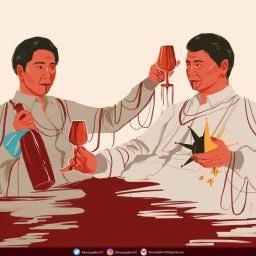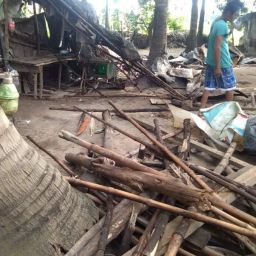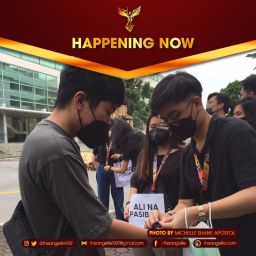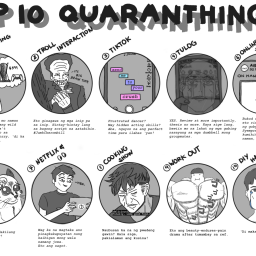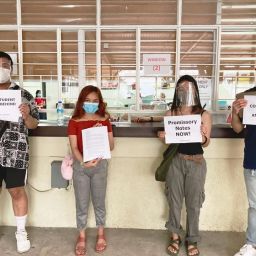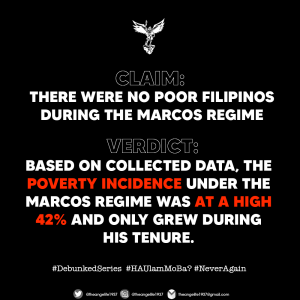 Debunked! Based on a collection of data, the poverty incidence under the Marcos regime was at a high 42% and only grew during his tenure.
Debunked! Based on a collection of data, the poverty incidence under the Marcos regime was at a high 42% and only grew during his tenure.
When Marcos took office in 1965, about 42% of Filipinos were below the poverty line. According to the Asian Development Bank, the poverty incidence rose to 52% in 1971 only a year before Marcos declared martial law. When the dictator was ousted by the people in 1985, a staggering 59% of the Filipinos were poor, which is three in five Filipinos.
POVERTY & HUNGER
In Negros, poverty and malnutrition were widespread. As the country’s cane production dropped by 30% and planters’ debt heightened to $225 million, putting 80% of the sugar cane land in hock. This adversely affected sugar worker, at least 190,000 lost their jobs which affected 1 million dependents, half of the island’s 2 million population. Former Overseas Director of Oxfam America, Michael Scott, states that one-fifth of the children under six in Negros were seriously malnourished.
The image of Joel Abong as he sat in his crib at the Corazon Locsin Montelibano Memorial Regional Hospital in Negros Occidental shows the grave implications of poverty under the Marcos regime. Dozens of children, including Joel Abong, died on Negors Occidental in 1985. This was taken on May 4, 1985.
John Silva shared the image of a 9-year old southern girl from Bacolod, who died several days later.
“I post this picture because aside from all the other nefarious deeds, the Marcos regime was responsible for the slow murder of the children and people of Negros”, Silva writes.
Urban poor families who were forced to live as squatters were forced to relocate in areas outside of Metro Manila. Houses were either burned or bulldozed, while families were literally dumped in the area where they were left to build they shanties with what they have salvaged from their demolished houses. Out of an estimated 15,000 families who lost their homes, 4,500 only went to Sapang Palay. By 1973, 400,000 squatter families have been displaced.
August 20, 1975, known as Presidential Decree (PD) 772, by Pres. Marcos which made squatting after this date a criminal offense which was previously dubbed as a public nuisance.
UNEMPLOYMENT & UNDEREMPLOYMENT
Unemployment is when a person is actively looking for a job but experiences an extended period without getting hired while underemployment is the underuse of a worker’s full capabilities.
During the Marcos years, unemployment went from 5.2 percent in 1978 to 5.9% in 1983. Underemployment went from 10.2 percent in 1978 to 29.0 percent in 1983 and 36.4 in 1984 to 28.4 in 1986.
There was a stalk income inequality as the poorest 60% were only able to receive only 22.5% of the income in 1980, which was 25% in 1970. Meanwhile, the richest 10% took a larger share of 41.7% in 1980, formerly 37.1% in 1970.
From 1978 to 1983, the number of workers without jobs increased from 800,000 to 1.2 million. But the figure for underemployment was more shameful, going from 1.6 million to 5.6 million.
DUTERTE’S PLUNGING ECONOMY
In present day, the Duterte administration has reflected the Marcos era’s economic downturn. According to the Philippine Statistics Authority (PSA), the Philippine economy dropped by 16.5% in April-June compared to last year’s data. Due to the COVID-19 pandemic, a decline in economic activities has resulted in a spike in unemployment, falling prices, and weak activity trade. This indicates a full-blown economic recession, the worst ever recorded, followed by the last few years of the Marcos authoritarian regime.
Other countries are also suffering from the economic downturn, but the country’s second-quarter performance happens to be the worst compared to major economies across Southeast Asia. The Philippines is now also the new virus “hotspot” in the region in spite of imposing the world’s longest lockdown.
According to the economic outlook of the International Monetary Fund (IMF), the gross domestic product (GDP) of the country may shrink by 3.6% this year. This is worse than what the government estimates to about a 2-3.4% decline.
Being the backbone of the economy, Duterte has also yet to protect the labor sector since its return for work amidst the global health crisis. Various labor groups firmly insist on real change against insufficient resources for wage subsidies and other social protection programs, the termination of 11,000 workers of ABS-CBN instead of providing more jobs, and trade union repression.
Four years into his administration, Duterte has heavily deprioritized increasing the minimum wage and has still not passed any law that will end contractualization despite clamoring the issue during his campaign period. Instead, his administration railroaded the Tax Reform for Acceleration and Inclusion (TRAIN) Law that imposed additional taxes on basic goods and services and strengthened neoliberal policies like deregulation and privatization.
GROWING POVERTY
To date, the PSA has announced around 4.6 million Filipinos are unemployed, while 7.1 Filipinos are underemployed as of this July.
As the government borrows more to respond to the health and socioeconomic crises inflicted by the COVID-19 pandemic, the Philippines has already settled to a P9.16 trillion debt this July. However, government economic managers claims that the country’s debt situation remains manageable.
The National Economic and Development Authority (NEDA) revealed that the poverty incidence rate will range from 15.5-17.5% next year, coming from 16.7% or 17.7 million people in 2018. On the other hand, IBON Foundation challenged the government’s inaccurate economic figures and poverty incidence estimates that are undeniably out of touch from reality.
Sources:
https://www.adb.org/sites/default/files/publication/27529/poverty-philippines-causes-constraints-opportunities.pdf
https://econ.upd.edu.ph/wp-content/uploads/2015/11/An_Analysis_of_the_Philippine_Economic_Crisis_1984.pdf
http://documents1.worldbank.org/curated/en/340011468758997924/pdf/multi0page.pdf
https://www.latimes.com/archives/la-xpm-1987-02-15-op-3420-story.html
https://ecommons.luc.edu/cgi/viewcontent.cgi?article=4209&context=luc_diss
https://newslab.philstar.com/31-years-of-amnesia/golden-era
Duterte gov’t to blame for worst economic collapse in PH history
https://www.gmanetwork.com/news/money/economy/750134/duterte-admin-to-blame-for-worst-economic-collapse-in-phl-history-ibon-chief/story/
https://cnnphilippines.com/business/2020/8/6/Q2-2020-PH-economy-recession.html?fbclid=IwAR1fS6HFRlpwgZSv2LHs4OTSYHa_Wbgk_2jwpxWqWJjETokmtUQROOmWhh8
https://rappler.com/business/unemployment-rate-philippines-april-2020
https://psa.gov.ph/statistics/survey/labor-and-employment/labor-force-survey/title/Employment%20Situation%20in%20July%202020
https://news.abs-cbn.com/business/09/02/20/ph-debt-hits-p916-trillion-in-july-as-govt-borrowings-continue-to-rise
https://www.adb.org/countries/philippines/poverty#:~:text=Poverty%20Data%3A%20Philippines,day%20in%202019%20is%202.7%25.
https://www.cnnphilippines.com/news/2020/9/10/NEDA-poverty-unemployment-2021.html

